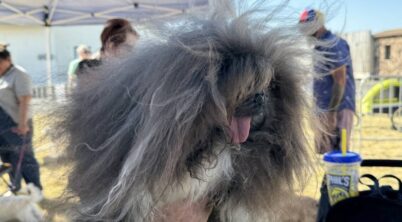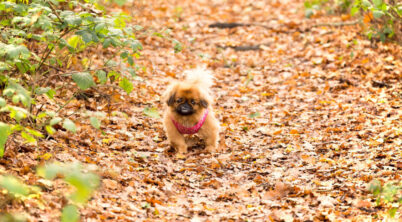The Pekingese, a regal breed hailing from ancient China, is known for its distinctive flat face and lion-like mane, traits that contribute to its unique respiration patterns. These dogs, once the cherished companions of Chinese royalty, possess a compact skull structure known as brachycephaly. This characteristic defines their appearance and influences their breathing, making Pekingese more prone to panting when compared to breeds with longer muzzles. Panting serves as a primary method for dogs to regulate body temperature, as it helps dissipate heat and allows for the exchange of warm air from the lungs with cooler air from the environment.
Panting in Pekingese can also signal excitement or stress, but when it becomes excessive or is accompanied by drooling, lethargy, or collapse, it is a cause for concern. The breed’s susceptibility to heatstroke necessitates a careful approach to their care. To ensure their well-being, especially during warmer weather, it is advisable to provide ample shade, fresh water, and a cool environment. Awareness of their limitations when it comes to physical activity in hot conditions is crucial for preventing heat-related health issues.
Owners of Pekingese should be mindful of the signs of abnormal panting that may indicate underlying health issues. Monitoring for allergy symptoms, possible infections, or respiratory difficulties is essential. Prompt veterinary care is important when a Pekingese exhibits symptoms beyond normal panting behavior, ensuring that the royal descendants of ancient China receive the care they need to thrive.
Pekingese Panting
Pekingese dogs are known for their distinctive physical appearance, which includes a flat face and short muzzle, classified as a brachycephalic breed. Due to this facial structure, Pekingese are more prone to panting as a result of their compromised airways.
Reasons for Panting:
- Thermoregulation: Unlike humans, dogs do not have an extensive system of sweat glands for cooling. Panting is their primary method of regulating body temperature.
- Excitement or Stress: Emotional states can also cause a Pekingese to pant. When excited, stressed, or anxious, panting may increase as part of their physiological response.
Potential Health Concerns:
| Concern | Description |
|---|---|
| Overheating | Pekingese can quickly become overheated due to less efficient cooling. |
| Respiratory Issues | Brachycephalic Airway Obstructive Syndrome may occur, leading to difficulty breathing and excessive panting. |
It’s essential to be vigilant about a Pekingese’s exposure to heat. Owners should provide:
- Shade and Fresh Water: Always available to prevent heatstroke and dehydration.
- Cool Environments: Especially during hot weather to minimize the risk of overheating.
In addition to environmental factors, panting could indicate underlying health issues. If a Pekingese exhibits excessive panting alongside symptoms like lethargy, vomiting, or collapse, they should be examined by a veterinarian promptly.
Proactive care includes:
- Avoiding Strenuous Exercise: Especially in hot weather to prevent respiratory distress.
- Monitoring for Signs of Distress: Recognizing early signs of heatstroke or breathing difficulties can help in seeking timely veterinary care.
Potential Health Concerns and Care
The Pekingese breed, with its origins rooted in ancient China, is known for its distinctive, affectionate character. One must take into account the special health care they require due to their unique physical structure, particularly in regard to respiratory issues.
Respiratory Issues and Panting
Pekingese dogs have a compact facial structure, which can lead to brachycephalic syndrome, a condition common in short-nosed breeds. This syndrome can cause:
- Difficulty breathing: They often have narrowed nostrils and elongated soft palates, which can obstruct airflow.
- Excessive panting: They may pant more than other dogs to compensate for the decreased airflow.
Owners should watch for signs of distress, which include labored breathing and an inability to settle. It is critical to keep Pekingese in a cool, controlled environment to prevent overheating and respiratory distress.
Professional Grooming and Home Care
The long, flowing coat of the Pekingese requires regular maintenance to keep the dog comfortable and healthy.
Grooming Needs:
- Daily brushing: To prevent matting and remove dirt and debris.
- Routine baths: With a gentle shampoo to maintain skin and coat health.
Professional Care:
- It may also involve visits to a professional groomer to manage the coat length and ensure their eyes and facial folds are clean to prevent infection.
Proper grooming and home care help prevent skin issues and ensure the dog remains free of additional stress or trauma associated with neglect. Regular care provides a good opportunity to check for any signs of health concerns, from skin issues all the way to more hidden problems that might require a veterinary examination.
Ethical Considerations in Ownership
When owning a Pekingese, it’s essential to recognize the ethical implications, including the provenance of the dog to ensure it is not a stolen object and the importance of responsible breeding practices to maintain the health and standard of the breed.
Combating the Stigma of Stolen Objects
The Pekingese has a storied history, once revered within the Chinese Imperial Palace. Ownership of these dogs used to be restricted, which sometimes led to dogs being stolen. Today, it’s crucial for potential Pekingese owners to ascertain their pet’s background to ensure they are not inadvertently supporting theft or illegitimate breeders. Here are steps to combat this issue:
- Verify the Breeder: Always verify the breeder’s credentials and inspect their facilities.
- Documentation: Insist on proper documentation of lineage, health clearances, and ownership history.
- Microchipping: Ensure the Pekingese is microchipped for easy identification if lost or stolen.
Promoting Responsible Breeding
Responsible breeding of Pekingese is vital to maintaining the breed’s health and characteristics. Overbreeding and neglectful breeding practices can lead to health issues and a distortion of breed standards.
- Health Screening: Breeders should conduct and disclose comprehensive health screening results for breeding pairs.Health ConcernScreeningBreathing DifficultiesRespiratory CheckEye IssuesOphthalmologist EvaluationOrthopedic ProblemsPhysical Examination by a Vet
- Breed Standards: Adherence to a documented code of ethics, such as that of the Pekingese Club of America, reinforces the commitment to breed standards.
- Education: Breeders must educate potential owners about the breed’s needs and characteristics.
Acquiring a Pekingese
When one considers acquiring a Pekingese, they must navigate select offers, identify unique gifts for dog lovers, and comprehend the online shopping tools that could affect their experience.
Navigating Exclusive Offers and Listings
To find a Pekingese, a potential owner should peruse exclusive listings on renowned dog-selling platforms and websites. Here are specific actions they should take:
- Check Reputable Breeders: Look for breeders who specialize in Pekingese and can offer pedigrees and health clearances.
- Online Classifieds: Websites like AKC MarketPlace may have exclusive offers on Pekingese puppies or adult dogs.
- Use Alerts: Set up email or app notifications on these platforms to receive updates on new listings.
Unique Gift Ideas for Dog Enthusiasts
Those looking to celebrate the acquisition of a Pekingese can find an array of unique gift ideas on platforms like Etsy. Consider the following:
- Custom Portraits: Commission a Pekingese portrait for a personal touch.
- Themed Merchandise: Search for Pekingese-themed clothing or accessories to celebrate the breed’s charm.
Understand the Impact of Browser Extensions
Online shoppers should understand how browser extensions can affect their shopping experience. These specifics can include:
- Ad Blockers: While they remove distracting ads, they can sometimes block valuable offers.
- Captcha Systems: Understand that captchas might pop up more often to verify you’re not a bot when using certain extensions.
- Browser Performance: Some extensions can slow down browser performance, hampering shopping efficiency.
Shoppers should also be aware that their browser choice and settings could affect the availability of particular deals and listings.
Connecting with the Pekingese Community
Engaging with fellow Pekingese enthusiasts is simplified through organized communities and events. These platforms and gatherings offer opportunities for Pekingese owners to share experiences, advice, and camaraderie.
Newsletters and Subscriptions for Enthusiasts
Subscribing to dedicated Pekingese newsletters helps enthusiasts stay informed on the latest breed-specific information. Receiving these newsletters typically requires:
- Email Address: Provide an email to receive updates.
- Subscription: Opt in through a Pekingese-focused website or social media page.
- Account Creation: Some sites might require setting up a user account.
Activities and Meetups
Meetups are a cornerstone of the Pekingese community, enabling owners and their pets to connect in person. Identifying these events can usually be done through:
- Social Media Groups: Facebook’s Pekingese communities often advertise local gatherings.
- Email Newsletters: Upcoming activities might be highlighted in your subscription content.
- Community Boards: Online forums or local bulletins may list events and their locations.
Each meetup presents a chance to share practical care tips, including safe ways to manage a Pekingese’s panting during physical activities.
* Banner photo by Rob Bixby, cropped | Some rights reserved








